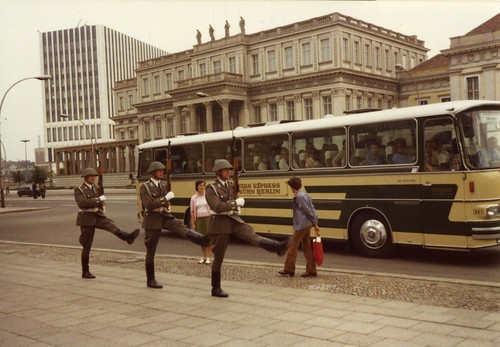 BERLIN THE EIGHTEEN YEARS
BERLIN THE EIGHTEEN YEARS
Throughout the 1970s and early 1980s, a quadrilateral agreement and treaties between German states provided the background for relations between West and East Berlin. The main source of dissatisfaction was the forced replacement of Western brands with Ostmarken, the level of the GDR authorities increased in 1980 year of 6.50 DM do 25 DM, which put a lot of potential travelers off. Overall, however, a certain degree of stabilization and normality has been achieved, which allowed both cities to function efficiently on a daily basis. Even after the Cold War partially revived with the Soviets entering Afghanistan in 1979 year. Berlin was still relatively calm. The only more serious incident was the shooting of a US officer for alleged espionage in Potsdam in the spring 1985 year.
As in the rest of West Germany, Berlin witnessed problems and attitudes crystallize and new radical movements flourished. Concern over the arms race and concern for the natural environment was widespread; feminism and the gay rights movement received increasing support. Before the elections, the groups of the left and the Greens created an Alternative List, the left-liberal newspaper Tageszeitung was also founded. Organized vacancy without title to them was a radical solution to the housing crisis in Berlin. W 1981 year new Christian Democratic authorities (chosen after a financial scandal, which forced the SPD to step down) they tried to displace the "wild tenants."” with approx 170 Apartment blocks and police brutality led to riots in Schönberg. The authorities compromised some of the "wild tenants."” housing rights, which had a profound effect on life in West Berlin. Social divisions for the first time since the late 1960s, which were then initiated, began to narrow. In May 1981 of the year, candidates from the Alternative List were elected for the first time to the Berlin Senate, and in the same year cultural life flourished, because art has gained new vitality.
With the beginning of the 1980s, US-Soviet relations cooled again, which increased anxiety about nuclear weapons. Anti-nuclear activists protested during President Ronald Reagan's visit to Berlin (June 1981). Treat tension and saber shaking, that characterized the Cold War in the 1950s and 1960s did not return to Berlin. W 1985 year, the USSR broke with the tradition of ancient leaders and the dynamic and relatively young Mikhail Gorbachev became the Party's First Secretary. The West did not immediately appreciate the importance of his glasnost and perestroika programs. and their initial impact on Berlin was negligible. The status of the city - and the division of Germany into separate states - seemed secured by a quadrilateral agreement and a basic treaty.
Unfortunately, the ideological hostility did not allow the two parts of the city to celebrate together 750 years of Berlin's existence in 1987 year. Separate anniversary celebrations were organized. In East Berlin, they were preceded by a huge city renewal project, covering the center. as well as the inner suburbs. SED was boasting. that the GDR is a mature socialist state, advancing in the first row of European countries. There was no need for glasnost or perestroika. indeed, they were treated with high suspicion.
In West Berlin, the CDU lost the election in the spring 1989 year for the SPD / Alternative List coalition, with Walter Momper as mayor. In Kreuzberg, this marriage was considered a 'value sale” from the Alternative List and demonstrations were organized, repressed with unjustified brutality, which provoked street fights. Further violence took place 1 May during the already traditional acts of vandalism of anarchists and other extreme leftists subscribing to anti-imperialist and anti-capitalist ideology. This time, however, the police chief ordered restraint, and there were no cracked skulls.
East Germany resists the first century As the decade passed, there were few signs of change in the East, but a lot was happening behind the scenes. The Protestant Church took under its wings environmental and peace organizations, which were the nascent opposition. However, the regime was just as inexorable, what used to be and did not agree to Gorbachev-style reforms as inappropriate for the NRO. The most memorable response to the demands for reform was that of the chief ideologist of the SED. Kurta Hagera, in April 1987 year: “You don't change the wallpapers in your own apartment just because of that, that a neighbor is renovating his.” Open opposition was nipped in the bud: in January 1988 In the year, a group of protesters were arrested and expelled from the GDR, who, during demonstrations in honor of Karl Liebknecht and Rosa Luxemburg, unfolded banners demanding more freedom.
Fearing the rapid changes taking place in the Soviet Union. In Poland and Hungary, the authorities banned the sale of the Soviet magazine Sputnik and the screening of a number of Soviet films from the 1960s recently released by censorship. GDR leaders also did not serve their subjects by honoring the wicked Romanian dictator Nicolae Ceausescu. Although Poland and Hungary were on the way to democracy, East Germany remained unmoved. SED leader Erich Honecker stated, that if necessary, this wall will stand for the next fifty or one hundred years, to protect "our republic from robbery”. The citizens of the GDR could only plunge into despair.
Few believed in the constant lies and slogans of propaganda. The authorities of the SED seemed completely alienated from the mood of the nation. It seemed, that there is no other way out, as soon as an individual escape. When Chris Gueffroy was shot while trying to cross the border in Neukolln 6 February 1989, nobody realized then, that this is the last person, who died trying to escape over the wall.
The breakthrough happened in such a dramatic and unexpected way, that the whole world was surprised.